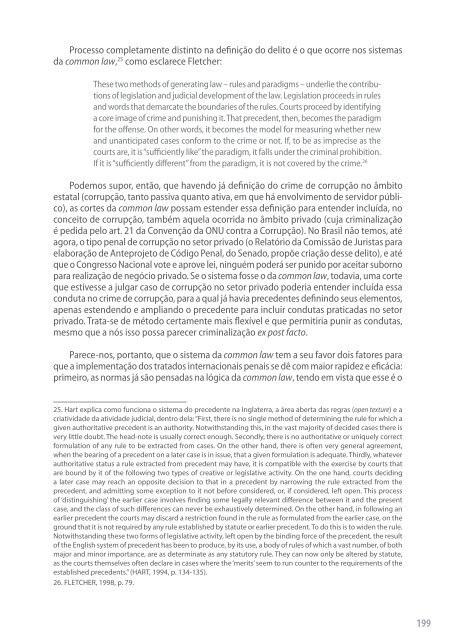TEMAS DE COOPERAÇÃO INTERNACIONAL
5I60JN6pE
5I60JN6pE
You also want an ePaper? Increase the reach of your titles
YUMPU automatically turns print PDFs into web optimized ePapers that Google loves.
Processo completamente distinto na definição do delito é o que ocorre nos sistemas<br />
da common law, 25 como esclarece Fletcher:<br />
These two methods of generating law – rules and paradigms – underlie the contributions<br />
of legislation and judicial development of the law. Legislation proceeds in rules<br />
and words that demarcate the boundaries of the rules. Courts proceed by identifying<br />
a core image of crime and punishing it. That precedent, then, becomes the paradigm<br />
for the offense. On other words, it becomes the model for measuring whether new<br />
and unanticipated cases conform to the crime or not. If, to be as imprecise as the<br />
courts are, it is “sufficiently like” the paradigm, it falls under the criminal prohibition.<br />
If it is “sufficiently different” from the paradigm, it is not covered by the crime. 26<br />
Podemos supor, então, que havendo já definição do crime de corrupção no âmbito<br />
estatal (corrupção, tanto passiva quanto ativa, em que há envolvimento de servidor público),<br />
as cortes da common law possam estender essa definição para entender incluída, no<br />
conceito de corrupção, também aquela ocorrida no âmbito privado (cuja criminalização<br />
é pedida pelo art. 21 da Convenção da ONU contra a Corrupção). No Brasil não temos, até<br />
agora, o tipo penal de corrupção no setor privado (o Relatório da Comissão de Juristas para<br />
elaboração de Anteprojeto de Código Penal, do Senado, propõe criação desse delito), e até<br />
que o Congresso Nacional vote e aprove lei, ninguém poderá ser punido por aceitar suborno<br />
para realização de negócio privado. Se o sistema fosse o da common law, todavia, uma corte<br />
que estivesse a julgar caso de corrupção no setor privado poderia entender incluída essa<br />
conduta no crime de corrupção, para a qual já havia precedentes definindo seus elementos,<br />
apenas estendendo e ampliando o precedente para incluir condutas praticadas no setor<br />
privado. Trata-se de método certamente mais flexível e que permitiria punir as condutas,<br />
mesmo que a nós isso possa parecer criminalização ex post facto.<br />
Parece-nos, portanto, que o sistema da common law tem a seu favor dois fatores para<br />
que a implementação dos tratados internacionais penais se dê com maior rapidez e eficácia:<br />
primeiro, as normas já são pensadas na lógica da common law, tendo em vista que esse é o<br />
25. Hart explica como funciona o sistema do precedente na Inglaterra, a área aberta das regras (open texture) e a<br />
criatividade da atividade judicial, dentro dela: “First, there is no single method of determining the rule for which a<br />
given authoritative precedent is an authority. Notwithstanding this, in the vast majority of decided cases there is<br />
very little doubt. The head-note is usually correct enough. Secondly, there is no authoritative or uniquely correct<br />
formulation of any rule to be extracted from cases. On the other hand, there is often very general agreement,<br />
when the bearing of a precedent on a later case is in issue, that a given formulation is adequate. Thirdly, whatever<br />
authoritative status a rule extracted from precedent may have, it is compatible with the exercise by courts that<br />
are bound by it of the following two types of creative or legislative activity. On the one hand, courts deciding<br />
a later case may reach an opposite decision to that in a precedent by narrowing the rule extracted from the<br />
precedent, and admitting some exception to it not before considered, or, if considered, left open. This process<br />
of ‘distinguishing’ the earlier case involves finding some legally relevant difference between it and the present<br />
case, and the class of such differences can never be exhaustively determined. On the other hand, in following an<br />
earlier precedent the courts may discard a restriction found in the rule as formulated from the earlier case, on the<br />
ground that it is not required by any rule established by statute or earlier precedent. To do this is to widen the rule.<br />
Notwithstanding these two forms of legislative activity, left open by the binding force of the precedent, the result<br />
of the English system of precedent has been to produce, by its use, a body of rules of which a vast number, of both<br />
major and minor importance, are as determinate as any statutory rule. They can now only be altered by statute,<br />
as the courts themselves often declare in cases where the ‘merits’ seem to run counter to the requirements of the<br />
established precedents.” (HART, 1994, p. 134-135).<br />
26. FLETCHER, 1998, p. 79.<br />
199


